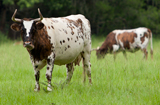Heritage Livestock Breeds
Heritage breeds are usually livestock breeds that colonists and explorers brought with them when they settled the Americas. Many breeds found in the Southeast are descended from animals introduced by Spanish explorers beginning in the 1500s.
Over time, natural selection and selective breeding led to these breeds being well adapted to the heat, humidity, pests, diseases, and forages of their southern environments. Many breeds are strongly identified with regional cultures throughout the Southeast.
Today, fewer farmers and ranchers use heritage breeds because of advances in modern medicines and the increase of imported and modern breeds, but there is interest in maintaining heritage breed populations--for genetic diversity, cultural conservation, and the inherent value of their breed characteristics.
Cracker Cattle
Florida Cracker cattle descend from cattle brought to Florida by the Spanish in the 1500s. Cracker cattle are heat-tolerant, resistant to parasites, and able to graze on the relatively low-quality forage found in Florida's natural areas.
These cattle are smaller, ranging from 600 to 1000 pounds. Their coloration varies, and cattle may even be brindle or spotted (exceptions are being gray or having SH Hereford spotting). Cracker cattle will have moderately long heads with horns that turn up sharply and tip back.
Cracker cattle are inexpensive to raise because of their parasite and disease resistance; they require no antibiotics, hormones, or antiparasitic drugs. This makes them good candidates for ranchers seeking to produce natural beef for farmers markets or consumers searching for "locally grown" or organic foods.
Pineywoods Cattle
Like Cracker cattle, the Pineywoods is a breed well adapted to the humid Southeast. They are heat-tolerant, resistant to parasites, and good foragers in scrubland environments of the Gulf States.
Similar to other heat-tolerant cattle, Pineywoods are small (600-1000 pounds). They have the varied colors and markings of Spanish cattle. Some family strains have specific colors or patterns. Pineywoods cattle are also horned, with variations in size and shape.
Cracker Horses
The Florida Cracker horse became a distinct breed from other Colonial Spanish horses because of their geographical isolation. They are known for their stamina, intelligence, strength, quickness, and easy ride.
These small saddle horses have a strong herding instinct and good agility over rough ground. This led to Cracker horses being integral to Florida's cattle industry because cowboys used them for herding and driving cattle over Florida scrubland.
Florida Cracker horses stand around 13 to 15 hands at the withers, with a straight or slightly concave profile, a short, well-defined jaw, short back, and sloping rump. Solid colors and grays are the most common, but they can be any color found in horses.
Cracker horses are mainly used as cattle horses, but some owners use them for pulling wagons and farm implements, trail riding, or in equine events, such as endurance riding and roping.
Spanish Goats
Many people do not realize that "Spanish goats" are an actual pure breed since the term has come to refer to cross-bred, indistinctive goats (sometimes called "brush" or "scrub" goats in the Southeast). There are different regional types and strains, depending on natural selection and geographic isolation.
Spanish goats are hardy and can thrive in rugged environments and on rough forage. Does have long life spans and high fertility.
Spanish goats have a wide range of weights (50-200 pounds depending on breeding history). They are usually horned with larger ears that are help horizontal and forward nest to the head. Their coats can be any color or pattern found in goats.
Interest in Spanish goats is increasing with the rise in popularity of the goat meat industry and recognition of the good qualities of the breed.
Gulf Coast Sheep
Gulf Coast sheep are a wool-sheep breed well adapted to the hot, humid climate in the Southeast.
Gulf Coast sheep are considered good milkers and have good mothering instincts. Their meat is also of a high quality. University studies have documented this breed's resistance to hoof rot as well as many internal parasites that limit sheep-rearing in the Southeast.
The breed is identified as medium size, open-faced, light boned and long legged, with low-density fleece that is white to black in color. Their fleece does not go below the knees.
More Information
For more information on raising livestock in Florida, as well as breed evaluation, contact your local county Extension office. Breed associations can also provide specific information on breed characteristics, as well as put you in contact with breeders.
Adapted and excerpted from:
J. Rey, Florida Cracker Cattle (AN240), Animal Sciences Department (05/2010).
J. Rey, The Florida Cracker Horse (AN216), Animal Sciences Department (4/2009).
"Breed Information--ALBC Conservation Priority List," American Livestock Breeds Conservancy (accessed 10/2011).

Related Sites & Articles
- UF/IFAS Publications
- Florida Cracker Cattle
- The Florida Cracker Horse
- Other Sites & Publications
- Florida Cracker Cattle and Cracker Horse Program--FDACS
- Florida Cracker Horse Association
- Getting Started with Rare Breeds--American Livestock Breeds Conservancy
- Gulf Coast Sheep Breeders Association

